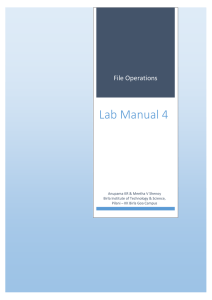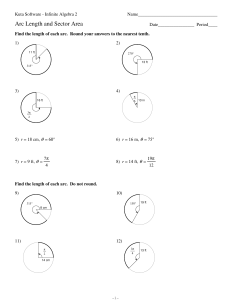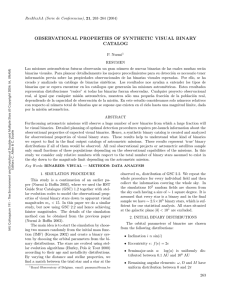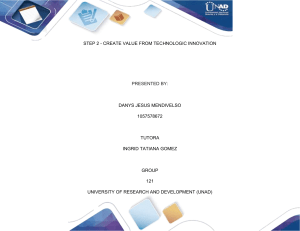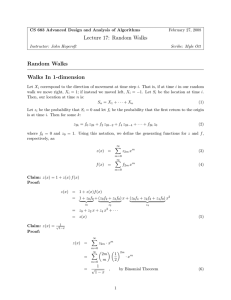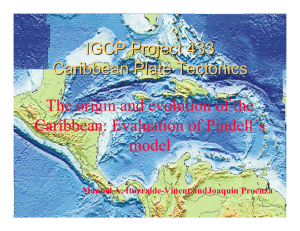PLC Ladder Diagram to Instruction List Transformation Algorithm
Anuncio
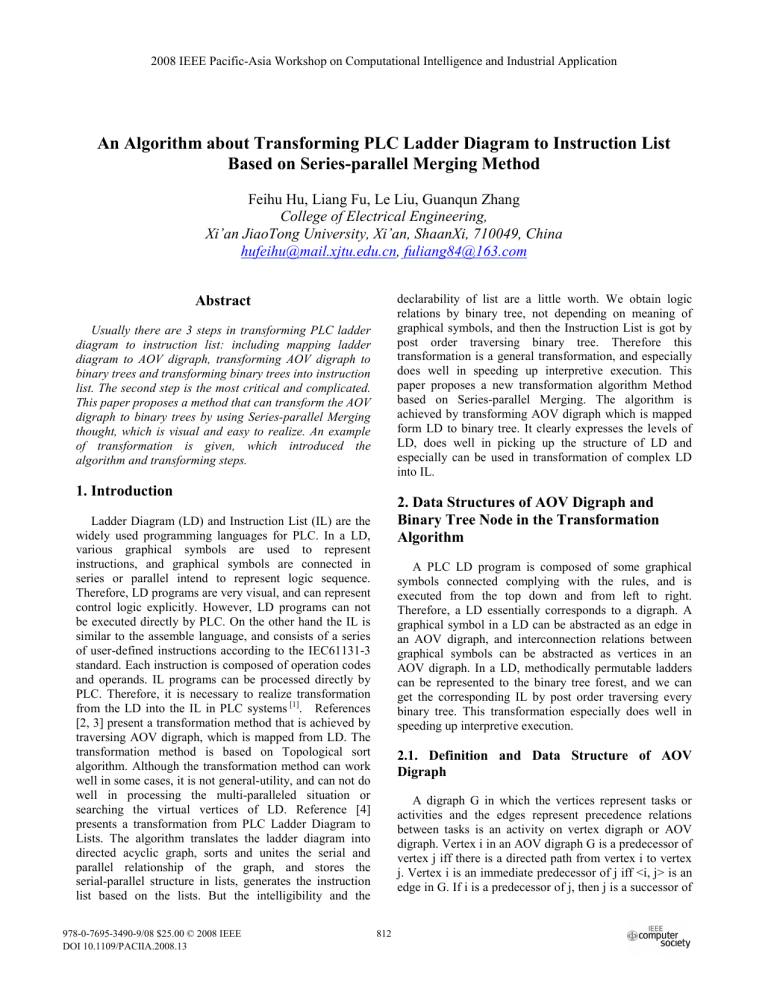
2008 IEEE Pacific-Asia Workshop on Computational Intelligence and Industrial Application An Algorithm about Transforming PLC Ladder Diagram to Instruction List Based on Series-parallel Merging Method Feihu Hu, Liang Fu, Le Liu, Guanqun Zhang College of Electrical Engineering, Xi’an JiaoTong University, Xi’an, ShaanXi, 710049, China [email protected], [email protected] declarability of list are a little worth. We obtain logic relations by binary tree, not depending on meaning of graphical symbols, and then the Instruction List is got by post order traversing binary tree. Therefore this transformation is a general transformation, and especially does well in speeding up interpretive execution. This paper proposes a new transformation algorithm Method based on Series-parallel Merging. The algorithm is achieved by transforming AOV digraph which is mapped form LD to binary tree. It clearly expresses the levels of LD, does well in picking up the structure of LD and especially can be used in transformation of complex LD into IL. Abstract Usually there are 3 steps in transforming PLC ladder diagram to instruction list: including mapping ladder diagram to AOV digraph, transforming AOV digraph to binary trees and transforming binary trees into instruction list. The second step is the most critical and complicated. This paper proposes a method that can transform the AOV digraph to binary trees by using Series-parallel Merging thought, which is visual and easy to realize. An example of transformation is given, which introduced the algorithm and transforming steps. 1. Introduction 2. Data Structures of AOV Digraph and Binary Tree Node in the Transformation Algorithm Ladder Diagram (LD) and Instruction List (IL) are the widely used programming languages for PLC. In a LD, various graphical symbols are used to represent instructions, and graphical symbols are connected in series or parallel intend to represent logic sequence. Therefore, LD programs are very visual, and can represent control logic explicitly. However, LD programs can not be executed directly by PLC. On the other hand the IL is similar to the assemble language, and consists of a series of user-defined instructions according to the IEC61131-3 standard. Each instruction is composed of operation codes and operands. IL programs can be processed directly by PLC. Therefore, it is necessary to realize transformation from the LD into the IL in PLC systems [1]. References [2, 3] present a transformation method that is achieved by traversing AOV digraph, which is mapped from LD. The transformation method is based on Topological sort algorithm. Although the transformation method can work well in some cases, it is not general-utility, and can not do well in processing the multi-paralleled situation or searching the virtual vertices of LD. Reference [4] presents a transformation from PLC Ladder Diagram to Lists. The algorithm translates the ladder diagram into directed acyclic graph, sorts and unites the serial and parallel relationship of the graph, and stores the serial-parallel structure in lists, generates the instruction list based on the lists. But the intelligibility and the 978-0-7695-3490-9/08 $25.00 © 2008 IEEE DOI 10.1109/PACIIA.2008.13 A PLC LD program is composed of some graphical symbols connected complying with the rules, and is executed from the top down and from left to right. Therefore, a LD essentially corresponds to a digraph. A graphical symbol in a LD can be abstracted as an edge in an AOV digraph, and interconnection relations between graphical symbols can be abstracted as vertices in an AOV digraph. In a LD, methodically permutable ladders can be represented to the binary tree forest, and we can get the corresponding IL by post order traversing every binary tree. This transformation especially does well in speeding up interpretive execution. 2.1. Definition and Data Structure of AOV Digraph A digraph G in which the vertices represent tasks or activities and the edges represent precedence relations between tasks is an activity on vertex digraph or AOV digraph. Vertex i in an AOV digraph G is a predecessor of vertex j iff there is a directed path from vertex i to vertex j. Vertex i is an immediate predecessor of j iff <i, j> is an edge in G. If i is a predecessor of j, then j is a successor of 814 812 node with degree greater than two. For binary trees we distinguish between the subtrees on the left and on the right, and for a LD program the priority of operating graphical symbols in left section is higher than that of graphical symbols in right section [5]. We use binary trees to represent the logic relations 'AND' and 'OR' in a LD program. In detail, leaf nodes represent graphical symbols, and non-leaf nodes represent the logic relations between left subtree and right subtree. We define the data structure of a binary tree node as follows: struct TwoTree { int NodeType; // type of binary tree: leaf node or // non-leaf node int Typedata; // type of leaf node to distinguish // graphical symbols struct TwoTree *left; //store a pointer of left subtree struct TwoTree *right; //store a pointer of right // subtree } TwoTree; i. If i is an immediate predecessor of j, then j is an immediate successor of i[5]. We can use adjacency matrix, adjacency list or orthogonal list as the data structure of AOV digraph. In this paper, orthogonal list is used for the data structure of AOV digraph. In orthogonal list, each vertex or arc in the corresponding directed graph has a node. The basic structure is as shown in Figure 1. Figure 1 Data structure of orthogonal list. We define the data structure of a graphical symbol as follows in order to store information of each graphical symbol in LD programs: const int MAX_VERTEX_NUM=2000; //maximum number of orthogonal list’s vertices typedef struct ArcBox // data structure of arc { int tailvex, headvex; // position information of arc’s // head vertex and tail vertex ArcBox *hlink; // pointer pointed to arc’s chain area //where arcs have the same head ArcBox *tlink; // pointer pointed to arc’s chain area //where arcs have the same tail TwoTree* TwoTreeinfo; // related binary trees //information stored in the arc }ArcBox; typedef struct VexNode // data structure of vertex { int data; // position information of vertex ArcBox *firstIn; // pointer pointed to the first input // arc whose tail vertex is this vertex ArcBox *firstOut; // pointer pointed to the first // output arc whose head vertex is this vertex }VexNode; typedef struct // data structure of orthogonal list { VexNode xList[MAX_VERTEX_NUM]; // list of all the vertices int vexNum, arcNum; // current number of arc and //vertices of this orthogonal list }OLGraph; 3. Description Algorithm of the Transformation Usually there are 3 steps in transforming LD to IL. The main ideas of the transformation are described as follows: In the first step, we transform LD program to AOV digraph. We use double linked list to store information of graphical symbols; and then we divided the generated double linked list into a series of relatively independent function modules; at last we should scan the function modules from left to right and from top down, and use orthogonal list to store the generated AOV digraph[7]. In the second step, we transform the generated AOV digraph to binary trees. This step is the most critical and complicated. This paper proposes a method by using Series-parallel Merging thought; infra it is described in detail. In the third step, we transform the generated binary trees to IL program. We realize it by post order traversing the binary trees [6]. 3.1. Introduction of Series-parallel Merging Thought LD uses series parallel connection of the graphical symbols to represent consecution. No matter how high-level complex LD logical relations, all of them are made of the most basic series parallel connections which are multi-level-nested and intercombined.We represent the most basic series parallel connections by using binary trees; and then we transform the AOV digraph’s several series or parallel basic arcs to an arc pointing to the corresponding new generated binary tree’s root. In this 2.2. Definition and Data Structure of Binary Tree Node A binary tree is an important type of tree structure which occurs very often. It is characterized by the fact that any node can have at most two branches, i.e., there is no 815 813 paper, we use signs ' * ' and ' + ' to represent the logic relations ' AND ' and ' OR ' in all pictures. Figure 2 arcNum=1, it means the AOV digraph is the simplest AOV digraph and then we in turn examine every element of the array xList which stores the vertices’ information; if a firstOut pointer in one of the vertex data structures is not null, we take out the TwoTreeinfo pointer from the arc pointed by the firstOut pointer; the acquired TwoTreeinfo pointer points to a root node of the binary tree which represented the AOV digraph. Then the transforming is over. ② If vexNum! =2 and arcNum! =1, it means that the AOV digraph isn’t the simplest. In this case, we do parallel merging to the AOV digraph. We in turn examine every element of the array xList; if a firstOut pointer in a vertex data structure is not null, we for the moment call the element of xList xList[i] and take out hlink pointer and tailvex of the arc pointed by the firstOut pointer; if xList[tailvex]’s firstin pointer isn’t null, we in turn traverse the linked list pointed by xList[i]’s hlink and find out the same arcs in the linked list pointed by xList[tailvex]’s tlink; then we in turn chain the same arcs’ TwoTreeinfo pointers by 'OR' binary nodes, save the new generated root node pointer in one of the same arcs and delete other same arcs in the linked lists pointed by hlink and tlink; we subtract the number of the linked list’s deleted arcs from arcNum; and then an element of the array xList has been processed and we go on processing the next element of the array xList. After processing all elements of the array xList, if vexNum=2 and arcNum=1, turn to step ①,otherwise turn to step ③. ③ If vexNum! =2 and arcNum! =1, it means that the AOV digraph isn’t the simplest. In this case, we do series merging to the AOV digraph. We in turn examine every element of the array xList; if a firstOut pointer in a vertex data structure is not null, we for the moment call the element of xList xList[i] and take out hlink pointer and tailvex of the arc pointed by the firstOut pointer; if there is only one element in the linked list pointed by the hlink and there is also only one element in the linked list pointed by the hlink in the arc pointed by xList[tailvex]’s firstOut pointer, we chain the two same arcs’ TwoTreeinfo pointers by 'AND' binary nodes, save the new generated root node pointer in the arc pointed by xList[i]’s firstOut pointer and give the value of xList[tailvex]’s tailvex to xList[i]’s tailvex; at last we delete all information in xList[tailvex], subtract 1 from arcNum and subtract 1 from vexNum; and then an element of the array xList has been processed and we go on processing the next element of the array xList. After processing all elements of the array xList, if vexNum=2 and arcNum=1, turn to step ①,otherwise turn to step ②. Simplification processes of basic parallel and series relations 3.2 Main Ideas of the Algorithm There is only one arc in the simplest AOV digraph. The AOV digraph simplified once by using Series-parallel Merging thought is not always the simplest; if it isn't the simplest we go on simplifying the simplified AOV digraph by cycling operation until it is. When we get the simplest AOV digraph, the only arc points to a root node of binary tree and the binary tree represent the initial AOV digraph. Start Do parallel merging to the AOV digraph. Y Is the AOV digraph simplest? N Do series merging to the AOV digraph. Is the AOV digraph simplest? N Y End Figure 3 The flow chart of transformation 3.3 Realization Steps of Building Binary Tree from the AOV Digraph 4. A Transformation Example ① Examine the number of vertices (vexNum) and arcs (arcNum) saved in orthogonal list;If vexNum=2 and The left of Figure 4 is an example of a LD application program which contains complex logic relations, stating 816 814 the logic equation (1). The right of Figure 4 is the AOV digraph of the LD program, and the virtual nodes (①, ②, ③, ④, ⑤, ⑥, ⑦, ⑧) respectively represent the parallel lines (vertical lines) between graphical symbols showing on the left of Figure 4. Y1=((X1+X2+X3)*(X4+X5)*(X6+X7)+(X9+X10)*(X11+X12) )*((X13+X14)*(X15+X16) +X17) (1) Figure 4 Ladder Diagram and corresponding AOV Digraph order traversing the binary tree in (d). This IL application program indicates the logic equation (2). Process the initial AOV digraph by the transformation algorithm. The (a), (b), (c) and (d) of Figure 5 describe the process by detailed. It can be seen that it takes twice series-parallel merging to transform the AOV digraph to final binary tree, which is shown at the lower in (d). Figure 6 is an IL application program formed by post Y1= X1X2X3++X4X5+X6X7+**X9X10+X11X12+*+ X13X14+X15X16+*X17+*Y1* (2) Obviously, (1) and (2) is equivalent. Thus, this transformation algorithm is correct. (a) The first parallel simplification. (b) The first series simplification. (c) The second parallel simplification. (d) The second series simplification. Figure 5 The transformation example 817 815 LD LD LD O R O R LD LD O R LD LD O R A N A N LD LD O R LD LD O R A N O R LD LD O R LD LD O R A N LD O R A N LD A N [6] Ge Fen, Wu Ning. Transformation Algorithm Between Ladder Diagram and Instruction List Based on AOV Digraph and Binary Tree [J]. Journal of Nanjing University of Aeronautics &A stronautics, 2006, 38(6): 754-758. [7] Wu Qian ,Tao Yi-yi ,Lu Chun yuan.Design and Implementation of Language Editing System in Sof tPLC Based on XML[J]. Mechanicnl Manufacture & Automation, 2007, (2): 100-102. X 1 X 2 X 3 X 4 X 5 X 6 X 7 D D X 9 X 10 X 11 X 12 D X 13 X 14 X 15 X 16 D D X 17 Y 1 D Figure 6 The generated IL 5. Conclusions In this paper, we have proposed a series-parallel merging transformation algorithm from the LD into the IL based on AOV digraph and binary tree. The algorithm is a general transformation algorithm, and especially can be used in transformation of complex LD into IL. This algorithm has been applied to a self-developed software for editing PLC program. It is proved by practical application that this algorithm can extract the IL from the LD completely, and can be used for the complex LD. Comparing to traditional topological sorting algorithm, this algorithm puts forward another way to transform LD to IL. References [1] Karl-Heinz J, Tiegelkamp M. IEC61131-3: programming industrial automation systems [M].Berlin, Germany: Springer-Verlag Company, 2001. [2] Cui Xiao-le, Zhou Zhuo-cen.The algorithm of translation between the ladder language and the sentence table language of PLC [J]. Microelectronics & Computer, 2000, 16(1):26-30. [3] Tan Jinjie , Cheng Lianghong , Yin Xuepeng. Mapping from Ladder Diagram to AOV Graph in Embedded PLC [J]. Computer Measurement & Control, 2004, 12(10):993-995. [4] Lin Maokai, Wang Xiaofang, Lin Heng .Transformation from PLC Ladder Diagram to Lists [J]. Computer Engineering, 2007, 33(13):75-77. [5] Yan Wei Min,Wu Wei Min.Data Structures[M]. BeiJing: Tsinghua University Press, 1997: 118-158. 818 816


